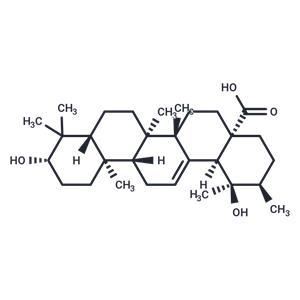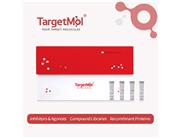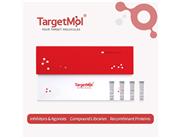| Name | Pomolic acid |
| Description | Pomolic acid has anti-cancer, anti-inflammatory and apoptotic activities, it can induce apoptosis in SK-OV-3 cells, which is mediated by the mitochondrial-mediated intrinsic and death receptor-induced extrinsic pathways. |
| In vitro | Oleanolic acid (1) was identified as an anti-HIV principle from several plants, including Rosa woodsii (leaves), Prosopis glandulosa (leaves and twigs), Phoradendron juniperinum (whole plant), Syzygium claviflorum (leaves), Hyptis capitata (whole plant), and Ternstromia gymnanthera (aerial part). It inhibited HIV-1 replication in acutely infected H9 cells with an EC50 value of 1.7 microg/mL, and inhibited H9 cell growth with an IC50 value of 21.8 microg/mL [therapeutic index (T. I.) 12.8]. Pomolic acid, isolated from R. woodsii and H. capitata, was also identified as an anti-HIV agent (EC50 1.4 microg/mL, T. I. 16.6). Although ursolic acid did show anti-HIV activity (EC50 2.0 microg/mL), it was slightly toxic (IC50 6.5 microg/mL, T. I. 3.3). A new triterpene (11) was also isolated from the CHCl3-soluble fraction of R. woodsii, though it showed no anti-HIV activity. The structure of 11 was determined to be 1beta-hydroxy-2-oxoPomolic acid by spectral examination. Based on these results, we examined the anti-HIV activity of oleanolic acid- or Pomolic acid-related triterpenes isolated from several plants. In addition, we previously demonstrated that derivatives of betulinic acid, isolated from the leaves of S. claviflorum as an anti-HIV principle, exhibited extremely potent anti-HIV activity[1] |
| Storage | Powder: -20°C for 3 years | In solvent: -80°C for 1 year | Shipping with blue ice. |
| Solubility Information | DMSO : 60 mg/ml (126.93 mM)
|
| Keywords | cancer | Pomolic acid | Inhibitor | inhibit | Randialic acid A | pentacyclic triterpene | ROS | Apoptosis | Prostate |
| Inhibitors Related | Stavudine | 5-Fluorouracil | Emtricitabine | Sodium 4-phenylbutyrate | L-Ascorbic acid | Lamivudine | Tributyrin | Chitosan oligosaccharide |
| Related Compound Libraries | Anti-Tumor Natural Product Library | Terpene Natural Product Library | Bioactive Compound Library | Traditional Chinese Medicine Monomer Library | Kinase Inhibitor Library | Anti-Viral Compound Library | Anti-infective Natural Product Library | Anti-Aging Compound Library | Anti-virus Traditional Chinese Medicine Monomer Library | Food as Medicine Compound Library |

 United States
United States



